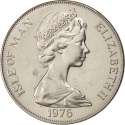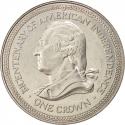You are about to finish your registration. Please check your mailbox (including spam folder). There should be a letter with a confirmation link. Check setting to make sure that your e-mail address is correct.
Send letter againDescription
A quarter, short for quarter dollar, is a U.S. coin worth 25 cents, one-fourth of a dollar. It has been produced since 1796. The choice of 1⁄4 as a denomination — as opposed to the 1⁄5 more common elsewhere — originated with the practice of dividing Spanish milled dollars into eight wedge-shaped segments. At one time "two bits" (that is, two "pieces of eight") was a common nickname for a quarter.
The Washington Quarter Dollar of 1932 was originally intended to be a commemorative coin to celebrate the 200th anniversary of George Washington's birth. The coin proved so popular that the design was continued as a regular-issue for circulation beginning in 1934 in silver.
1976 was the 200th anniversary of the signing of the Declaration of Independence. Though actual independence was not won until the end of the Revolutionary War in 1783, the year 1776 has always held a special place in the hearts of Americans. Thus, it was felt fitting to create a numismatic tribute to this special anniversary and new reverse designs were created for the Washington Quarter Dollar, Kennedy Half Dollar, and Eisenhower Dollar. The obverse of each coin bore a dual date (1776-1976).
Obverse
_Cents_25/1976_27.02.2016_12.56-60.jpg)
|
A head of Washington facing left, with "Liberty" above the head, the date below, and "In God We Trust" in the left field. LIBERTY |
|---|---|
Reverse
_Cents_25/1976_27.02.2016_12.56_01-60.jpg)
|
A colonial drummer facing left, with a victory torch encircled by thirteen stars at the upper left circled by 13 stars, one star for each state in the Union when the Declaration of Independence was signed. UNITED STATES OF AMERICA |
| Edge |
119 reeds |
25 Cents
Washington Quarter
KM# 204 Schön# 205
Swap now (1 offer)
Characteristics
| Type | Commemorative Issue (Circulating) |
| Material | Copper Nickel Clad Copper |
| Weight | 5.67 g |
| Diameter | 24.3 mm |
| Thickness | 1.75 mm |
| Shape |
|
| Alignment | Coin |
| Mints |
Denver Mint (D) Philadelphia Mint (no mintmark) San Francisco Mint (S)
|
Related coins
200th Anniversary of the United States
_Cents_25/1976_27.02.2016_12.56.jpg)
_Cents_25/1976_27.02.2016_12.56_01.jpg)


_Cents_25/1976_28.02.2016_00.53-125.jpg)
_Cents_25/1976_28.02.2016_00.53_01-125.jpg)
_Dollar_0.5/1976_17.03.2016_00.41-125.jpg)
_Dollar_0.5/1976_17.03.2016_00.41_01-125.jpg)